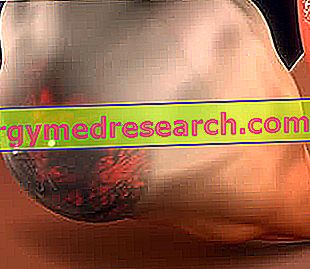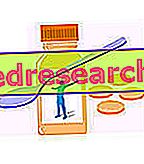Definition
Fortunately rare, Hodgkin's lymphoma delineates a tumor form affecting the lymphatic system; in particular, the neoplasm involves the liver, spleen and bone marrow, without affecting or damaging the neighboring districts of an extra-lymphatic nature.
Causes
The cause responsible for the manifestation of Hodgkin's lymphoma is still an open question; however, it has been observed that this neoplastic form tends to manifest itself above all in AIDS patients and in patients infected in the past with Epistein-Barr virus (responsible for diseases such as mononucleosis, Burkitt's lymphoma and even tonsillitis). Moreover, it seems that the subjects most at risk are adults aged between 20 and 30, and elderly over the age of seventy.
Symptoms
The very first hint with which Hodgkin's lymphoma generally begins is an abnormal swelling at the level of a lymph node, which also slowly extends into nearby lymph nodes. The patient may complain: fatigue, redness of the skin, chills, difficulty breathing, chest pain, fever, spleen pain / swelling, loss of appetite, widespread itching, cough.
Information on Hodgkin's Lymphoma - Drugs for the Treatment of Hodgkin's Lymphoma is not intended to replace the direct relationship between health professional and patient. Always consult your doctor and / or specialist before taking Hodgkin's Lymphoma - Hodgkin's Lymphoma Medication.
drugs
Due to the research addressed to the treatment of Hodgkin's lymphomas, the prognosis is currently good in 80% of affected patients; being a disease of oncological competence, it is evident that Hodgkin's lymphomas are mainly treated with chemotherapy. Some patients are also subjected to radiant treatment (radiotherapy): this medical practice is generally aimed at patients who have tumor cellular residues after chemotherapy, or lymphoma masses at an early stage. Radiation therapy is not always recommended, given the high probability of unpleasant and dangerous side effects, such as the increased risk of secondary leukemia and the formation of solid malignant neoplastic masses.
In relapsing forms, bone marrow transplantation can also be hypothesized, using the patient's own stem cells.
Other alternative / adjuvant interventions include: taking antibiotics (in the case of bacterial superinfections) and blood transfusion (to balance the possible loss of red blood cells and platelets)
Pharmacological treatment is based on the association of multiple drugs; in fact, mono-chemotherapy does not give satisfactory beneficial effects for the treatment of Hodgkin's lymphoma. For example, the combination of 4 drugs of different classes is used, such as mecloretamine, procarbazine, prednisone and vincristine (so-called "MOPP" protocol), but also the use of doxorubicin and bleomycin is a widely used pharmacological cocktail.
- Mecloretamine (eg. Mustargen): it is an exponent of cytotoxic chemotherapeutic agents. The dosage varies according to the subject and the severity of the tumor; for example, it is possible to administer the active ingredient at a dose of 0.4 mg / kg intravenously once, or 0.2 mg / kg IV once a day for 2 days. However, the dosage most commonly used to treat Hodgkin's lymphomas is 6 mg per square meter of body extension, on days 1 and 8 of a 4-week cycle. Consult your doctor.
- Procarbazine (eg. Natulan): for monotherapy (a formula that is rarely used), the dosage for the treatment of Hodgkin's lymphomas is 2-4 mg / kg on the first week of treatment. Modulate the dosage at 4-6 mg / kg per day until symptoms improve, or so that the platelets fall below the 100, 000 / mm³ value and the white blood cells below 4, 000 / mm³. The administration of this active ingredient is particularly useful for reducing nausea and vomiting. When the drug is used in combination with other chemotherapy drugs, the most suitable dosage is 100 mg per square meter, for 2 weeks.
- Prednisone (eg. Solprene, Deltamidrina): exponent of synthetic corticosteroids; the drug is used in combination with antineoplastics to relieve Hodgkin's lymphoma symptoms. The dose should be determined by your doctor.
- Vincristine (eg Vincristine, Vincristine PFIZER, Vincristine TEV): the standard dose is 1.4 mg / m2 ev (duration of infusion: 1 minute), in a single dose. The dosage just described should generally be repeated once a week, even if the dose can vary from 0.4 to 1.4 mg / m2. Do not exceed 2 mg.
- Doxorubicin (eg. Caelyx, Myocet): belonging to the pharmacological class of antineoplastic antibiotics, the active ingredient is often used in therapy for the treatment of Hodgkin's lymphoma (and not Hodgkin's) in association with other chemotherapeutic drugs, at the dose of 40-60 mg / m2 intravenously, every 21-28 days Alternatively, administer 60-75 mg / m2 IV once every 21 days.
- Bleomycin (eg. Bleomycin CRN, Bleomycin VTE): before starting the standard therapy for the treatment of Hodgkin's lymphoma, it is recommended to give the patient a minimal dose of the drug, in order to avoid unpleasant anaphylactic reactions. Then, if the patient is able to tolerate the drug, it is possible to take it at a dosage of 0.25-0.50 units / kilo (or 10-20 units / m2) intravenously, intramuscularly or subcutaneously, once every 7- 14 days. The maintenance dose should generally be increased from one unit a day to five units a week, intravenously or intramuscularly. Generally, following the above treatment plan, Hodgkin's lymphoma symptoms regress significantly in 2 weeks. If no benefit is found, the probability of improvement is low or zero.



